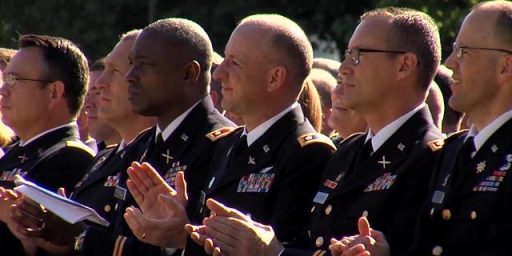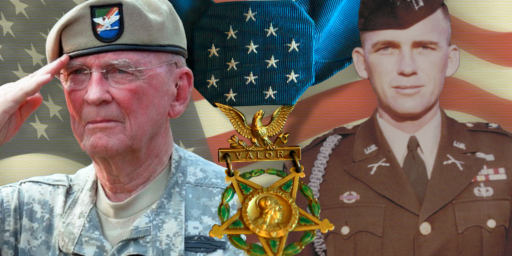Army Expert Soldier Badge Approved
An idea that's both long overdue and problematic.

In an effort to both remedy a perceived inequity and recognize excellence is basic skills, the Army has unveiled yet another badge.
As early as October, soldiers could be earning the Expert Soldier Badge — accoutrements targeted at everyone who isn’t an infantryman, combat medic or Special Forces soldier.
The badge will test general soldiering skills, Command Sgt. Maj. Edward W. Mitchell, senior enlisted leader at the Center for Initial Military Training, said in an interview with Army Times. By offering testing and a badge, the Army hopes to provide incentive for units to train their warrior tasks and battle drills while in garrison and during peacetime.
The new badge, which is an initiative of Training and Doctrine Command, will be equivalent to the Expert Infantryman Badge and Expert Field Medical Badge and mirror how those badges test core infantry and combat medic proficiency outside of deployments.
“We wanted every soldier to make sure they understand that they are experts in their field,” Mitchell said. “Achieving the new badge … requires a much higher standard, just like its cousins, which are the EIB and the EFMB.”Pass rates during the ESB pilot testing were similar to that of the EIB and EFMB, the Army said in a statement Friday.
“This is not a badge to award so that the entire Army now has an ‘expert’ badge to wear,” said TRADOC Command Sgt. Maj. Timothy A. Guden in a service news release provided in advance to Army Times.“As it is now, not every Infantryman or Special Forces soldier earns the EIB and not every medic earns the EFMB,” Guden said. “Keeping with the same mindset, this is a badge to award to those who truly deserve recognition as an expert in their career field.”
Because no soldiers have the new badge yet, testing will be administered early on by soldiers with the other expert badges, since about 80 percent of the tasks will be the same.
—-Army Times, “Army officially unveils Expert Soldier Badge“
TRADOC hasn’t fully worked out the standards but they’re similar to those of the existing badges but less MOS-specific:
The standards and regulation are expected to be completely finalized by September, but standards will not be adjusted for age, gender or any other criteria, the release said.
The badge will require a five-day testing period. Test events will be based on the warrior tasks and battle drills first introduced at basic training, as well as up to five events selected by the brigade commander from a unit’s Mission Essential Task List.These could include reacting to an IED attack, marking CBRN-contaminated sites or building a defensive fighting position.
To qualify to take the test, soldiers must pass the Army Combat Fitness Test, qualify as “Expert” on the M4 Carbine or M16 rifle and be recommended by their chain of command. The test will then involve another ACFT, day and night land navigation, individual testing stations and it will end with a 12-mile foot march.
It seems to me that the badge should either be MOS-specific—essentially an EFMB for every skill group—or Army-wide. My preference would be the latter, given that everyone is testing for the same badge.
But, if they did this, it would beg the obvious question: Why not simply get rid of the existing badges?
It all started in November 1943, in the midst of World War II. The Army wanted to improve the morale of those serving in the Infantry by giving them a giant badge to signify their sacrifice. Over time, the Combat Infantryman Badge became among the most prestigious symbols in the Army. While it’s simply an “I was there” award for those in the largest MOS, it’s a signifier of having been in harm’s way.
The Expert Infantryman’s Badge was created by the same executive order but never acquired anything like the same prestige despite it being in many ways harder to get. Even though the CIB is awarded for showing up and the EIB is awarded for passing a series of grueling tests and meeting high standards, the EIB looks and is treated as a lesser version of the CIB. Soldiers who have earned both are allowed to wear only one, and everyone goes with the CIB.
The Combat Medical Badge was created in January 1945 and made retroactive to Pearl Harbor Day. Its purpose was identical to that of the CIB: to raise morale by signifying the sacrifices made by field medics who were exposed to direct ground combat.
The Expert Field Medical Badge wasn’t created until 1965, is much harder to earn than even the EIB, but is nonetheless treated as the bastard stepchild of the CMB.
As long as I can remember—which is to say at least since the early 1980s—soldiers from other MOS’ have bitched about the unfairness of the restrictions on these awards. None of us doubt the sacrifices made by Infantry and Special Forces soldiers or the medics that support them or begrudge them recognition. But why wouldn’t, say, a field artillery forward observer or a combat engineer supporting these units not be eligible, too, if they came into a firefight? Indeed, some of the other branches came up with their own equivalent badges but none were ever recognized by the Army at large.
This issue became more apparent during the present wars, as the distinction between infantry and non-infantry combat diminished. Further, it became highlighted that female soldiers exposed to direct action—or even captured by the enemy—were ineligible for the award. Finally, after many fits and starts, the Combat Action Badge was created in 2005 with eligibility retroactive to the start of the Afghanistan campaign. It was inevitable, I suppose, that an “Expert” variant would be created.
But, again, if the Army is recognizing non-grunts for participation in firefights and passing through a soldier skills gauntlet, why not simply do away with the infantry and combat medic variants? Until and unless they do, the Army-wide badges will always be viewed as less-than participation trophies.





Well that’s a pretty interesting glimpse into a slice of the world I (at least) encounter very rarely. So thank you.
Brings a memory to front-of-mind: In James Jones’ novel ‘Some Came Running’, the protagonist had a job in supply during the breakout from Normandy and somehow got involved in the Battle of the Bulge. He has to explain several times — as I recall — that he was entitled to the Combat Infantryman’s long-rifle that he wore.
This new version of that award is made inaccessible to REMF’s who get the unexpected privilege of shooting for their lives, yes? Doesn’t quite seem right. But maybe there’s salad enough to cover such an event.
I have mixed feelings but I was the ultimate REMF and so I caveat w that. Wasn’t much of a difference in many places whether you drove trucks (big target) or out kicking in doors as a retasked Artillerymen. Danger was everywhere. But your avg midgrade officer or NCO nowadays have more awards than someone who went from North Africa to Berlin and stays in and retires. Petraeus in his dress uniform looked a bit much compared to his Marine/ Navy counterparts